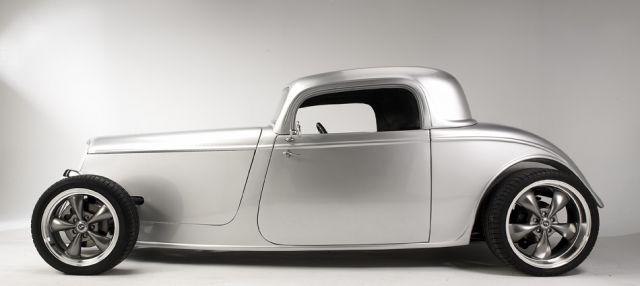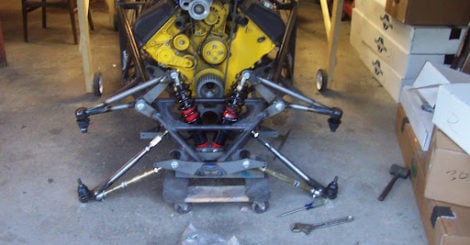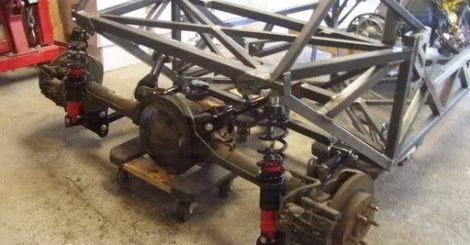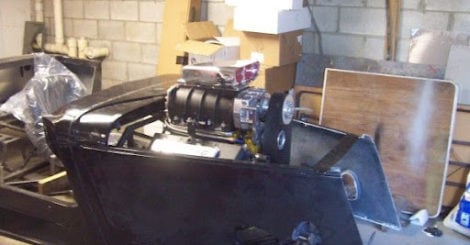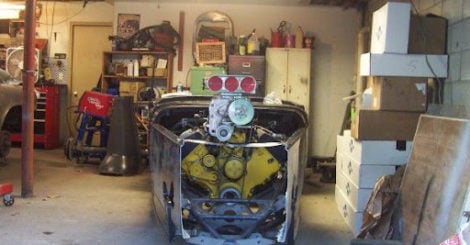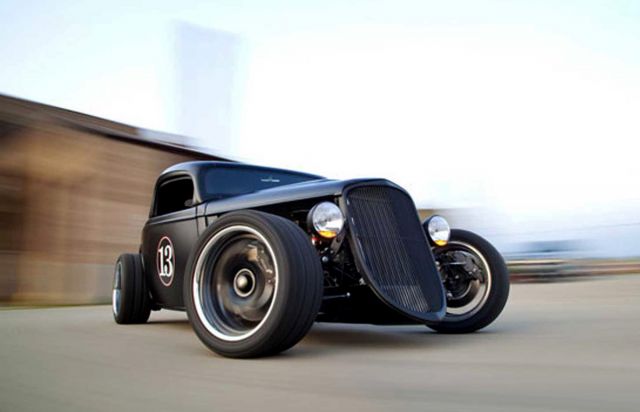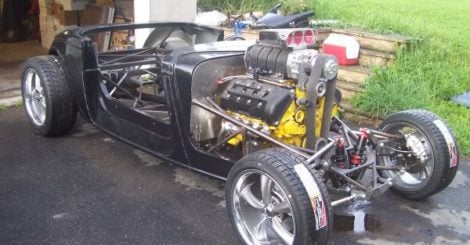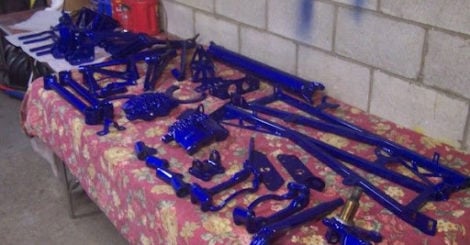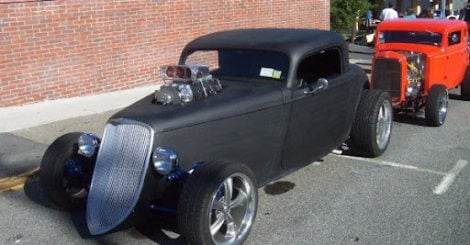You just ordered that Factory Five Racing [2] ’33 Hot Rod Kit that you’ve been dreaming of putting together, or you’re currently considering it. This is obviously an exciting prospect and at the same time there’s still quite a bit of work that lies ahead. Where do you start? What are you getting in those boxes exactly? When the inevitable happens, who do you call for help? What resources are available to you as a builder?
Last month we took you on an inside tour of the Factory Five facilities [3] in Wareham, Massachusetts to see these amazing machines come to life first-hand. Chances are, if you’ve ordered the Hot Rod kit [4] then you are probably pretty comfortable swinging wrenches to a certain degree.
Some of you may have built rods or customs before or restored an older car to some extent. However, you might not have any experience assembling a complete car from the ground up. Well that’s where we come in; to speak with the pros and help answer some of your questions. We’ve taken an in-depth look and researched the task ahead, talked with people who have built this and other kits, as well as assembled expert advice directly from the manufacturer.
Getting Started
Prior to even ordering your kit, it’s a good idea to get an understanding of who you’ll be dealing with and what kind of task is really at hand. We talked with a few builders who have constructed this kit as well as Factory Five employees directly.
Our Build Panel
Dave Smith – President of Factory Five. Of the group we talked with, Dave probably needs the least amount of introduction. He’s a hands on kind of guy, active in all aspects of his company. He’s built and driven every kit that Factory Five has to offer and is as qualified as anyone out there to give great build advice.
George Robitaille – Has built several cars including an FFR ’33 Hot Rod. George goes by the name Arrowhead on many forums online regarding kit cars, FFR products and other things and he has his own build site where he helps others with questions and tech info.
Rob Kinnan – Has built a ’33 FFR Hot Rod for his own use and as the subject of our 5-day build series [5]. Kinnan writes for Rod Authority and is currently a contributor here at Power Automedia so he was able to give us some insight and share his thoughts on such an undertaking.
John Cotton – Has built several cars from kits and restored numerous other vehicles since 2003. Although he has not built a Factory Five ’33 Hot Rod specifically, his build expertise and advice are worth heading to any builders who aren’t quite as experienced.
The Kits
Let’s start by taking a look at what you’re getting in the boxes after slapping down that hard earned moola. As we mention in our recent Factory Five shop tour, owner Dave Smith said he’d probably never produce a Hot Rod/Street Rod kit and with some good reason. Street Rods, on a large scale have generally been all about looks and very little about real performance and good driving characteristics. That’s not to say that they aren’t fun to drive and that they weren’t once the epitome of high performance, but hop out of any sporty car built in the last twenty years and into a Hot Rod and you’ll see exactly what we mean.
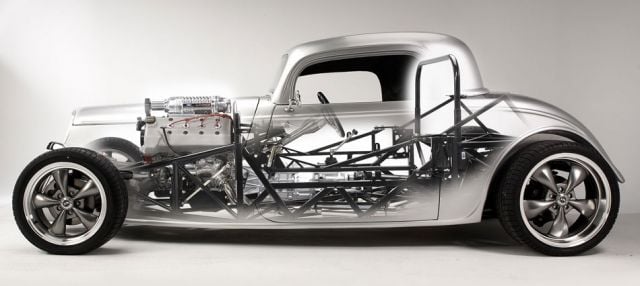 [6]
[6]With race car inspired chassis and suspension, the FFR ’33 is like no other Street Rod kit before it.
The original ’33 Fords rolled off the assembly lines during the depression and many rods still on the road today bear a strong resemblance in both appearance and design to those cars from nearly eighty years ago.
Factory Five became inspired and put fourth the engineering and R&D to create a rod that would be unlike anything ever offered to the general public; lightweight, sports car-like handling, the adaptability for running various powertrains, safety, and to boot – the good looks associated with paying homage to those that came before.
Kits are available as Complete, Stage 1 or Stage 2. “As we started selling hot rods the customers asked us to break the package into stage 1 and stage 2,” says Dave Smith, president of Factory Five Racing. “Stage 1 is basically everything needed to drive the rolling chassis and stage 2 being the body and trim and completion parts to be done.” Stage 1 and Stage 2 kits are half the price of the complete kit and buying the kit one stage at a time may also cut back on parts shock and getting overwhelmed in the project build phase.
The shock of seeing all those boxes and parts, the frame and the body, and donor parts filling up your garage and workspace can become quite overwhelming to folks who have never undertaken a major car project before. Reducing the project into two parts or stages helps create a more steady workflow plan and can ease this type of apprehension.
If you are going to buy the kits in stages, obviously you’d start with Stage 1 first, assemble it for mockup and then order Stage 2 to complete your project.
|
Stage 1 Cost: $9990 |
Stage 2 Cost $9990 |
|
Frame |
Body, Panels and Components |
|
Aluminum Chassis Panels |
Interior Kit |
|
Front Suspension |
Gauges |
|
Rear Suspension |
Wiring Harness |
|
Front Brake Kit |
Exterior Lighting Components |
|
Steering System |
Seats |
|
Fuel System Parts |
Seat Belts |
|
Cooling System Parts |
Fuse Panel |
|
Engine & Transmission Mounts |
Steering Wheel |
|
Exhaust |
Grille |
|
Driveshaft |
F5R Badging |
|
Pedal Box Components |
Windscreen |
|
Fasteners |
|
|
Assembly Manual |
|
|
Complete Kit Includes all of the above – $19990 |
|
Basic Build Advice
We’ve got a three day build school for those who want to build it first before taking the plunge! -Dave Smith
The cost of this school at $799 for the three day weekend school, includes a $500 rebate toward the purchase of your Factory Five Kit. The school will take you and a group of other students through a complete build in the course of the weekend. This hands on experience is highly recommend by those who have participated in it and gone on to build a car project of their own.
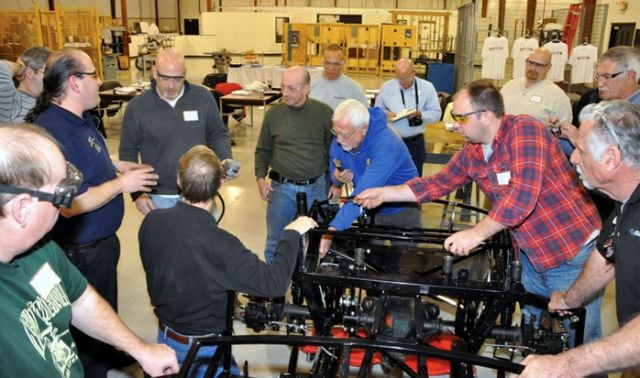 [8]
[8]Factory Five Build school gives current and potential owners an opportunity to get their hands dirty and learn how to build a car. Attending the school also makes you eligible for a discount on your purchase.
John Cotton gave us this piece of advice with regard to building project cars. “It’s the old adage about eating an elephant, you can do it, just do it one piece at a time.” Smith also seemed to second that by adding, “It’s like any other major car project, you just start small and work your way up.”
Cotton has bought kits new and in various states of completion and helped see many projects through. He recalls, “A lot of guys buy kits and stare at the piles of parts in their garage, basement, or wherever, and six months into it they look at all these boxes and start telling themselves that they can’t do it. But it’s the most rewarding experience to see it through, you CAN do it, just take one bite at a time.”
Get Organized
Everyone we talked with recommended that regardless of which kit you go with, your first step should be to take a careful inventory and make sure that you received everything you ordered. If something is missing, call Factory Five as soon as you can, so that a call can be placed for missing parts once inventory is completed.
As Robitaille told us, “Calling them two years after delivery might raise the question of whether you actually got the part or probably just misplaced it yourself.” He also stressed to us that it’s best to leave everything in the boxes and create a numbering system to reference each box; this will make finding parts faster and easier when the time comes to use them.
After that Kinnan said, “First thing I would suggest is to lay out all the parts and boxes in the order that you’ll be installing them.” This too will help tremendously from a time and frustration standpoint as everything should be in the proper order for assembly.
Make a Plan
A definite build plan can go a long way in keeping you on track. Robitaille said one of the most important factors in this build plan is to be realistic about what you can do ahead of time. What are you going to complete yourself and what will have to be sent out for someone else to do? For example, you may be extremely skilled at engine building or chassis construction but limited in the paint and body department either by way of skill or facilities to do so. In such a case, you would probably choose to tackle this part of the build by having an outside company or individual do the body and paint work for you. This should be accounted for ahead of time in your planning and budgeting.
Some people can become frustrated early on, leaving or selling their project in various states of uncompleted limbo. This story is designed to be a guide to ensure this won't happen to you!
Cotton also added to this advice “Don’t go buy parts at the start because you will often change your mind as you go. I have enough unused parts to do another project but they’re all for different cars.” Incidentals and items such as engine dress up, interior details, even the wheel and tire package should not necessarily be purchased ahead of time. Focus on what you need to get the car mocked up, in paint and prepared for final assembly. Don’t order anything until a week or two before you know you’ll need it and be sure of the part and decision before you buy it, that way you won’t end up with a garage full of trinkets like Cotton.
Smith also echoed these ideas in a similar fashion, “You need make a budget and build plan, and you also have to be honest about your driving and how you’ll actually use the car.”
Mocking parts up to get the right fit will be crucial to a quality final outcome.
More Tips
When questioned our build panel and resources to put together some basic tips for first-time builders. Robitaille suggested that as part of your investigation into the build process, aside from going to the FFR build school, that it’s a good idea to spend some time on the forums, and check out some of the individual build sites and blogs.
The Right Tools
Smith told us, “I can almost build the thing [’33 Hot Rod Kit] with normal tools in the normal guy’s garage.” The general consensus from everyone seems to be that you really just need a decent tool set. While this is different in definition to everyone here, the basics should include both metric and standard sockets, wrenches (box and open), ratchets, hammer, screwdriver set, jack and jack stands.
I can almost build the thing with normal tools in the normal guy’s garage. -Dave Smith
A lift is also not a necessity, although it will make life much easier as you get further along. Cotton told us, “That car goes up and down on that lift all day long when I’m working on it, I wouldn’t build another car without it.”
We also found a user on the forums that recommended an air riveter, which is a tool that most of us won’t have in our home tool box. However, the ’33 Hot Rod kit does include a large number of rivets and as such, the air powered riveter will not only save you time but may save you some wear and tear on your hands and wrists and some frustration in assembling the riveted components.
On the subject of tools Kinnan agreed that the riveter is a good idea, “Definitely a powered rivet gun… that’ll save you a lot of time and pain, along with good wiring tools like a crimper, soldering iron, that kinda thing.”
Mock Up
Make Some Tools
George Robitaille made this wooden body buck to store and move the body while he was in the mock up process. This kept the body safe when he didn’t need it and easily accessible when he did. Get creative; creativity and ingenuity are the spirit of custom car building and hot rodding.
Some builders recommend using roll bar in padding and tape to protect parts like the chassis during mock up or even during final assembly checks. We also found a good suggestion of using contact paper, heavy paper or thin cardboard to make templates of things like gauge and control layouts and tape those in place prior to cutting them out. This can allow you to play around with the layout of these areas before you make a cut in a piece of the body or other part that would be difficult to correct should you change your mind down the road.
While mock up will obviously add a large number of hours to your project as you are basically assembling, disassembling and reassembling the car – you will find that in the end, the finished product will turn out much better by heading this advice.
Put it in 3-D
Another suggestion we heard a few times is to put your project in 3-D. As a member of the car cult, chances are pretty good that you have assembled model cars as a kid or even as an adult (who says models are only for kids). Find a model kit or even a toy that somewhat resembles your ’33 Hot Rod and get creative. Use some spray paint or an airbrush to try out your paint scheme ideas and colors. This is especially useful if you’re going for a more complex paint job such as two tones, stripes, flames or other graphics. If you’re paint scheme dosen’t pan out the first time on the model, blast it with some gray primer and start over.
You can also enlist the help of some digital artists to help create a rendering or concept of what you’re project will look like. This will serve as a reference and can also especially help in the final design and paint process. In the long term this extra planning step could save you thousands of dollars with respect to paint work that you could be gambling on and not end up liking the final result.
Where To Get Help
Inevitably, you may eventually get stuck at some point or another. Whether it’s a roadblock in the build, or a hurdle you can’t get past on your own, it’s likely that you’re going to want some help along the way. You’re not alone in your build efforts and definitely keep that in mind when you hit a stumbling point.
Left to Right: Robitaille used two engine stands to make his own frame rotisserie. This allowed him to mock up the build, disassemble numerous times to get fitment correct and allow parts to be painted and powdercoated.
Go To The Source
An e-mail or phone call to Factory Five [21] can in many cases be a quick and easy way to get the answers you may need. The folks at FFR take their jobs and their cars very seriously and are dedicated to serving customers from start to finish to help make sure their build is a successful one.
Check The Forums
There are two forums that we found chock full of useful information. The first is linked to the main Factory Five web site and is thefactroyfiveforum.com [22] and there’s also the unofficial forum located at www.ffcars.com [23]. Both of these forums have friendly communities full of experienced and unexperienced builders alike. A search of the forum topics will likely reveal your question has come up before and a solution has already been posted. If your situation proves to be unique however, then you’ll find these communities tend to act quickly to help their fellow enthusiasts.
Left: Using a plastic model or toy to test your paint scheme can help you determine the end result better and potentially save you thousands of dollars. Right: Using paper templates to determine gauge locations can help create a cool looking and unique instrument and controls setup like this one.
Find a Local Builder
As part of their service to you, Factory Five can provide you with contact information for builders near you. Since there is a kind of brotherhood amongst builders, this may also prove an invaluable resource to your project at hand. A fellow builder may be able to offer you tips if you get stuck, information about any special steps they needed to take, as well as be willing to lend a helping hand.
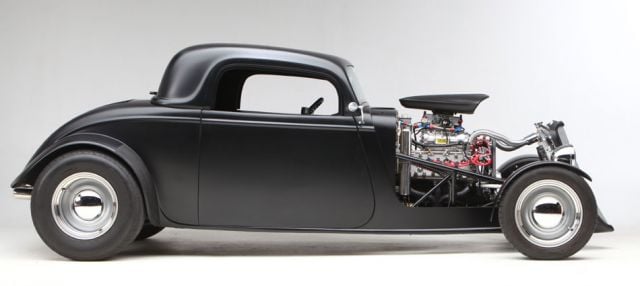 [26]
[26]Factory Five can setup the ’33 Hot Rod kit to accept variety of engines from old school to the latest crate motor craze.
Flash Mob of Builders
Like we mentioned, there are social media communities of enthusiastic builders all over the web and chances are some live near you. Gather some buddies and put the call out about a “build party” where you supply food and drinks. This might just be your ticket to having a whole mess of experienced and willing builders show up at your location and help you quickly assemble your car. Many of these enthusiastic folks are happy to swing some wrenches and share in some comradery with fellow gear heads. Plenty of pizza and beer goes a long way on the bribery scale.
Search Online
There are a ton of builder blogs and web sites dedicated to building the ’33 Hot Rod. For this article we actually spoke with George Robitaille after finding his build site [27] online.
George's Hot Rod before and after paint, enjoying the payoff of the build.
Ultimately the success of your build relies on you and your abilities as well as how much time, money and effort you’re willing to put into it. It’s good to know that there are many who have gone before you, who are more than willing to lend their knowledge and in many cases their time to help you succeed where they already have. If this is something you have given any thought to, from everyone we spoke with, it can definitely be one of the most rewarding experiences, so take a shot – but plan ahead and you’ll be glad you did!
